[English] 日本語
 Yorodumi
Yorodumi- PDB-1nez: The Crystal Structure of a TL/CD8aa Complex at 2.1A resolution:Im... -
+ Open data
Open data
- Basic information
Basic information
| Entry | Database: PDB / ID: 1nez | ||||||
|---|---|---|---|---|---|---|---|
| Title | The Crystal Structure of a TL/CD8aa Complex at 2.1A resolution:Implications for Memory T cell Generation, Co-receptor Preference and Affinity | ||||||
 Components Components |
| ||||||
 Keywords Keywords |  IMMUNE SYSTEM IMMUNE SYSTEM | ||||||
| Function / homology |  Function and homology information Function and homology informationcytotoxic T cell differentiation / : / MHC class I protein complex binding / T cell mediated immunity / antigen processing and presentation of peptide antigen via MHC class I / Endosomal/Vacuolar pathway / DAP12 interactions / Antigen Presentation: Folding, assembly and peptide loading of class I MHC / ER-Phagosome pathway / DAP12 signaling ...cytotoxic T cell differentiation / : / MHC class I protein complex binding / T cell mediated immunity / antigen processing and presentation of peptide antigen via MHC class I / Endosomal/Vacuolar pathway / DAP12 interactions / Antigen Presentation: Folding, assembly and peptide loading of class I MHC / ER-Phagosome pathway / DAP12 signaling / Immunoregulatory interactions between a Lymphoid and a non-Lymphoid cell /  regulation of membrane depolarization / plasma membrane raft / cellular defense response / positive regulation of calcium-mediated signaling / antigen processing and presentation of endogenous peptide antigen via MHC class Ib / Neutrophil degranulation / regulation of membrane depolarization / plasma membrane raft / cellular defense response / positive regulation of calcium-mediated signaling / antigen processing and presentation of endogenous peptide antigen via MHC class Ib / Neutrophil degranulation /  T cell activation / calcium-mediated signaling / antigen processing and presentation of exogenous protein antigen via MHC class Ib, TAP-dependent / cellular response to iron(III) ion / negative regulation of forebrain neuron differentiation / response to molecule of bacterial origin / T cell activation / calcium-mediated signaling / antigen processing and presentation of exogenous protein antigen via MHC class Ib, TAP-dependent / cellular response to iron(III) ion / negative regulation of forebrain neuron differentiation / response to molecule of bacterial origin /  regulation of erythrocyte differentiation / regulation of iron ion transport / MHC class I peptide loading complex / HFE-transferrin receptor complex / T cell mediated cytotoxicity / cellular response to iron ion / antigen processing and presentation of endogenous peptide antigen via MHC class I / positive regulation of T cell cytokine production / MHC class I protein complex / multicellular organismal-level iron ion homeostasis / positive regulation of T cell mediated cytotoxicity / peptide antigen assembly with MHC class II protein complex / negative regulation of neurogenesis / positive regulation of receptor-mediated endocytosis / MHC class II protein complex / cellular response to nicotine / phagocytic vesicle membrane / peptide antigen binding / positive regulation of cellular senescence / antigen processing and presentation of exogenous peptide antigen via MHC class II / positive regulation of immune response / negative regulation of epithelial cell proliferation / positive regulation of T cell activation / antimicrobial humoral immune response mediated by antimicrobial peptide / sensory perception of smell / negative regulation of neuron projection development / MHC class II protein complex binding / late endosome membrane / T cell differentiation in thymus / antibacterial humoral response / iron ion transport / T cell receptor signaling pathway / protein refolding / protein homotetramerization / defense response to virus / cellular response to lipopolysaccharide / intracellular iron ion homeostasis / defense response to Gram-negative bacterium / amyloid fibril formation / regulation of erythrocyte differentiation / regulation of iron ion transport / MHC class I peptide loading complex / HFE-transferrin receptor complex / T cell mediated cytotoxicity / cellular response to iron ion / antigen processing and presentation of endogenous peptide antigen via MHC class I / positive regulation of T cell cytokine production / MHC class I protein complex / multicellular organismal-level iron ion homeostasis / positive regulation of T cell mediated cytotoxicity / peptide antigen assembly with MHC class II protein complex / negative regulation of neurogenesis / positive regulation of receptor-mediated endocytosis / MHC class II protein complex / cellular response to nicotine / phagocytic vesicle membrane / peptide antigen binding / positive regulation of cellular senescence / antigen processing and presentation of exogenous peptide antigen via MHC class II / positive regulation of immune response / negative regulation of epithelial cell proliferation / positive regulation of T cell activation / antimicrobial humoral immune response mediated by antimicrobial peptide / sensory perception of smell / negative regulation of neuron projection development / MHC class II protein complex binding / late endosome membrane / T cell differentiation in thymus / antibacterial humoral response / iron ion transport / T cell receptor signaling pathway / protein refolding / protein homotetramerization / defense response to virus / cellular response to lipopolysaccharide / intracellular iron ion homeostasis / defense response to Gram-negative bacterium / amyloid fibril formation /  adaptive immune response / learning or memory / cell surface receptor signaling pathway / adaptive immune response / learning or memory / cell surface receptor signaling pathway /  receptor complex / defense response to Gram-positive bacterium / lysosomal membrane / external side of plasma membrane / receptor complex / defense response to Gram-positive bacterium / lysosomal membrane / external side of plasma membrane /  innate immune response / innate immune response /  protein kinase binding / protein kinase binding /  Golgi apparatus / Golgi apparatus /  cell surface / protein homodimerization activity / cell surface / protein homodimerization activity /  extracellular space / identical protein binding / extracellular space / identical protein binding /  plasma membrane / plasma membrane /  cytosol cytosolSimilarity search - Function | ||||||
| Method |  X-RAY DIFFRACTION / X-RAY DIFFRACTION /  SYNCHROTRON / SYNCHROTRON /  MOLECULAR REPLACEMENT / Resolution: 2.1 Å MOLECULAR REPLACEMENT / Resolution: 2.1 Å | ||||||
 Authors Authors | Liu, Y. / Xiong, Y. / Naidenko, O.V. / Liu, J.H. / Zhang, R. / Joachimiak, A. / Kronenberg, M. / Cheroutre, H. / Reinherz, E.L. / Wang, J.H. | ||||||
 Citation Citation |  Journal: Immunity / Year: 2003 Journal: Immunity / Year: 2003Title: The Crystal Structure of a TL/CD8alphaalpha Complex at 2.1 A resolution: Implications for modulation of T cell activation and memory Authors: Liu, Y. / Xiong, Y. / Naidenko, O.V. / Liu, J.H. / Zhang, R. / Joachimiak, A. / Kronenberg, M. / Cheroutre, H. / Reinherz, E.L. / Wang, J.H. | ||||||
| History |
|
- Structure visualization
Structure visualization
| Structure viewer | Molecule:  Molmil Molmil Jmol/JSmol Jmol/JSmol |
|---|
- Downloads & links
Downloads & links
- Download
Download
| PDBx/mmCIF format |  1nez.cif.gz 1nez.cif.gz | 137 KB | Display |  PDBx/mmCIF format PDBx/mmCIF format |
|---|---|---|---|---|
| PDB format |  pdb1nez.ent.gz pdb1nez.ent.gz | 111.3 KB | Display |  PDB format PDB format |
| PDBx/mmJSON format |  1nez.json.gz 1nez.json.gz | Tree view |  PDBx/mmJSON format PDBx/mmJSON format | |
| Others |  Other downloads Other downloads |
-Validation report
| Arichive directory |  https://data.pdbj.org/pub/pdb/validation_reports/ne/1nez https://data.pdbj.org/pub/pdb/validation_reports/ne/1nez ftp://data.pdbj.org/pub/pdb/validation_reports/ne/1nez ftp://data.pdbj.org/pub/pdb/validation_reports/ne/1nez | HTTPS FTP |
|---|
-Related structure data
| Similar structure data |
|---|
- Links
Links
- Assembly
Assembly
| Deposited unit | 
| ||||||||
|---|---|---|---|---|---|---|---|---|---|
| 1 |
| ||||||||
| Unit cell |
|
- Components
Components
| #1: Protein | Mass: 31660.002 Da / Num. of mol.: 1 / Source method: obtained synthetically Details: The peptide was chemically synthesized. The sequence of the peptide is naturally found in Mus musculus (mouse). References: UniProt: P14433, UniProt: P14432*PLUS | ||||
|---|---|---|---|---|---|
| #2: Protein |  Beta-2 microglobulin Beta-2 microglobulinMass: 11704.359 Da / Num. of mol.: 1 / Source method: obtained synthetically Details: The peptide was chemically synthesized. The sequence of the peptide is naturally found in Mus musculus (mouse). References: UniProt: P01887 | ||||
| #3: Protein | Mass: 14397.548 Da / Num. of mol.: 2 / Source method: obtained synthetically Details: The peptide was chemically synthesized. The sequence of the peptide is naturally found in Mus musculus (mouse). References: UniProt: P01731 #4: Sugar | ChemComp-NAG /  N-Acetylglucosamine N-Acetylglucosamine#5: Water | ChemComp-HOH / |  Water Water |
-Experimental details
-Experiment
| Experiment | Method:  X-RAY DIFFRACTION / Number of used crystals: 1 X-RAY DIFFRACTION / Number of used crystals: 1 |
|---|
- Sample preparation
Sample preparation
| Crystal | Density Matthews: 2.09 Å3/Da / Density % sol: 41.08 % | ||||||||||||||||||||||||||||||||||||
|---|---|---|---|---|---|---|---|---|---|---|---|---|---|---|---|---|---|---|---|---|---|---|---|---|---|---|---|---|---|---|---|---|---|---|---|---|---|
Crystal grow | Temperature: 300 K / Method: vapor diffusion, hanging drop / pH: 7.5 Details: 2.0M ammonium sulfate, 2.0% PEG 400, 5% DMSO, 0.1M HEPES, pH 7.5, VAPOR DIFFUSION, HANGING DROP, temperature 300K | ||||||||||||||||||||||||||||||||||||
| Crystal grow | *PLUS | ||||||||||||||||||||||||||||||||||||
| Components of the solutions | *PLUS
|
-Data collection
| Diffraction | Mean temperature: 160 K |
|---|---|
| Diffraction source | Source:  SYNCHROTRON / Site: SYNCHROTRON / Site:  APS APS  / Beamline: 19-ID / Wavelength: 1.01 Å / Beamline: 19-ID / Wavelength: 1.01 Å |
| Radiation | Protocol: SINGLE WAVELENGTH / Monochromatic (M) / Laue (L): M / Scattering type: x-ray |
| Radiation wavelength | Wavelength : 1.01 Å / Relative weight: 1 : 1.01 Å / Relative weight: 1 |
| Reflection | Resolution: 2.1→50 Å / Num. obs: 35619 / % possible obs: 98.9 % / Observed criterion σ(F): 0 / Observed criterion σ(I): 0 / Rmerge(I) obs: 0.071 / Net I/σ(I): 9.7 |
| Reflection | *PLUS Num. measured all: 171093 |
| Reflection shell | *PLUS Highest resolution: 2.1 Å / Lowest resolution: 2.18 Å / % possible obs: 100 % / Rmerge(I) obs: 0.5 / Mean I/σ(I) obs: 3.1 |
- Processing
Processing
| Software |
| ||||||||||||||||
|---|---|---|---|---|---|---|---|---|---|---|---|---|---|---|---|---|---|
| Refinement | Method to determine structure : :  MOLECULAR REPLACEMENT / Resolution: 2.1→50 Å / Cross valid method: THROUGHOUT / σ(F): 0 / Stereochemistry target values: Engh & Huber MOLECULAR REPLACEMENT / Resolution: 2.1→50 Å / Cross valid method: THROUGHOUT / σ(F): 0 / Stereochemistry target values: Engh & Huber
| ||||||||||||||||
| Displacement parameters |
| ||||||||||||||||
| Refinement step | Cycle: LAST / Resolution: 2.1→50 Å
| ||||||||||||||||
| Xplor file |
| ||||||||||||||||
| Refinement | *PLUS Lowest resolution: 50 Å | ||||||||||||||||
| Solvent computation | *PLUS | ||||||||||||||||
| Displacement parameters | *PLUS | ||||||||||||||||
| Refine LS restraints | *PLUS
|
 Movie
Movie Controller
Controller


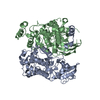


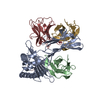
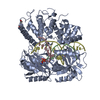
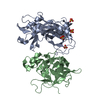
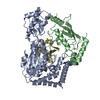
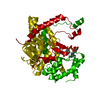
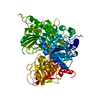

 PDBj
PDBj












